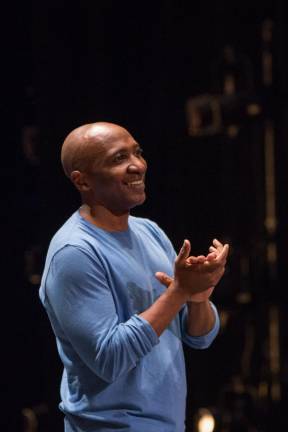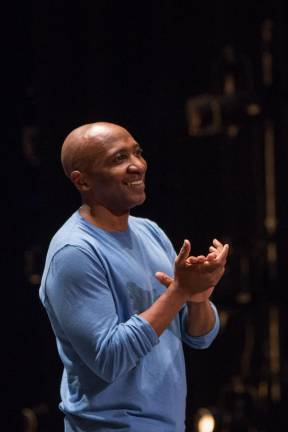Earl Mosley loves to move. As an arts educator, choreographer, and founder of the dance company Earl Mosley’s Diversity of Dance (EMDOD) in Brooklyn, Mosley has brought joy and the art of dance to the lives of hundreds of young dancers from around the country. EMDOD’s programs for young dancers, such as Earl Mosley’s Institute of the Arts and Hearts of Men (a dance experience exclusively for men), not only produce dance performances at the highest level, but also help people overcome adversity through the joyful, healing power of movement. We sat down with Mosley last week to discuss Dancing Beyond, EMDOD’s recent benefit performance to help end cancer, toxic masculinity, and how dance can lift the spirit.
What do students get out of performing in Diversity of Dance and how does the experience enhance their lives?
The obvious part is that they get a chance to perform. And some of these students wouldn’t ordinarily get an opportunity to work with some of the choreographers that we’ve had, from Hope Boykin on, like Matthew Rushing...They’ve had the chance to work with some choreographers that are usually only [working with] major dance companies.
And they get a chance to meet people not from their spaces, because you don’t know who’s going to be in the studio when you show up. In one studio, there could be literally a kid in the eighth grade with a freshman in college with a senior in high school. So it brings people together and then they form relationships and lifelong friendships. That’s really powerful—it’s everything.
Yes, they get a chance to dance, but I think the other part of it that’s equally as strong is relationships.
The last few years have been challenging and tumultuous politically and socially, particularly for people of color and LGBTQ+ individuals. How have current affairs affected how you approach or develop your artwork?
When we had no choice but to all sit still for almost two years of our lives, and not be able to do the things we love to do that I feel like we all took for granted, I think it gave me and so many people no choice but to check inside. Like, “What am I really doing” and “What’s my real purpose here?” and “What am I really trying to say?” “Who do I want to be?” And I knew I was that person that loved to have a positive impact on young people, but now, I am that person that must have a positive impact on young people and I must speak up when I don’t think something is right, particularly when it comes to anything that I feel is anti-gay, anti-anything...Don’t sit back. Speak up. And whatever platform you have to speak up, use it at whatever level that you can. Because during George Floyd, during Covid, it showed me that we all have the ability to make a difference if we just put in the effort.
For men, dance can carry a strong stigma and be a hard art form to approach. How do you, particularly with Hearts of Men, make dance easier for men to approach and participate in to eliminate that stigma?
First thing is, I try to take dance out of the equation of like, “if you only want to be a dancer can you participate in this.” Because I think that alone also discourages people...Firstly then, I want to take that away as the criteria and make it about if you just want to move, or if you want to share in the space, come on in. And know that this space is for combatting the preconceived idea of what is masculinity versus being feminine. I think that’s the core.
What really is the issue is, how do men share in this space where they feel they can hug each other, they can say how they’re feeling, they can be vulnerable, and they can share ideas of what it really means to be masculine. I think that’s the core of it.
My mentor Dudley Williams he helped me with [dealing with this stigma]. He said, “Mosley, the best way to deal with that is to make it intergenerational. Because, if people see themselves in you, and they trust what you have to say, then everyone can say, ‘see, we’re all here together.’” I’ve had people in there participating over the years that are sixty-eight, sixty-nine years old. And the youngest person has been maybe seven years old. When we have that dichotomy happening, everyone tends to drop their shoulders and show who they really are and feel good about it.
I’ve had kids in there who are trans. I’ve had kids in there who have told me, “Sorry I’m late, Mr. Mos, but my grandmother still hates the fact that I loved to dance and so I slept outside all night.” There’s a lot of that still happening today and it’s happened over the years, and I think Hearts of Men has created a bonding ceremony, so to speak, where people come into the space and they feel like, “I don’t have to pretend that I’m something that I’m not.”
What is the relationship between the body and spirit when one is dancing?
Movement is such a spiritual thing. It’s such a deeper...You know those moments when you’re by yourself and you’re talking to yourself? I think dance is the same way. When you’re dancing with yourself, and you’re just grooving. For me, it’s like a conversation with myself. And no one else can hear it, but I can hear it. And it helps me to get through hard times. When I just get up and just start moving.
As an older person, I still feel that way when I see the students light up, when you see that someone’s got it. When I say “got it”, not necessarily physically got it, but they’ve got it. Like there’s this inner glow that just happens. And that’s when I feel this thing that “movement is it.” Yeah, movement is it.
Yes, they get a chance to dance, but I think the other part of it that’s equally as strong is relationships.” Ed Mosley, chirographer, dancer and founder of Ed Mosley’s Diversity of Dance Studio.

